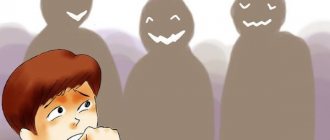Stuttering is a violation of the tempo and rhythm of speech organization, which is associated with a convulsive (contracted) state of the muscles that form speech. Stuttering is known as one of the ancient speech disorders. The essence of this condition, the mechanisms of its development, causes, symptoms and approaches to treatment differed significantly in different periods of the development of speech therapy. Different views on this problem are due to different levels of science, teachings and schools dealing with this condition. In this article we will approach this topic from the perspective of modern teachings and achievements in the field of treatment of this condition.
Stuttering is known as one of the ancient speech disorders.
Causes of stuttering
There are 2 types of causes of stuttering. The former create a predisposition, the so-called “soil” for the development of the disease. The second group of reasons are “impetuses” to development, reasons.
Predisposing reasons
A combination of one of the following unfavorable conditions and a strong irritant (stress) is enough for the development of stuttering in a child.
A lot depends on the parents. If parents have the so-called Neurotic burden, which includes infectious, neurological and other diseases that negatively affect the functions of the nervous system, then all these factors can affect the child. Infections can be transmitted, and increased irritability can negatively affect the child’s mental state.
A lot depends on the parents.
When we evaluate developmental causes, it is important to look back to the period before, during and after childbirth. It is necessary to study the presence of birth injuries, infections, asphyxia and other factors that may affect the functioning of the brain. It is equally important to study the child’s family, because it is likely that among his blood relatives there may be people who stutter.
As for the child’s body, it is necessary to pay attention to its neurogenic characteristics and constitutional predisposition. These reasons include increased vulnerability and irritability, nightmares, enuresis, and diseases of the nervous system. Of course, we should not forget that a child may go through a stage in which age-related anatomical and physiological features of the central nervous system are present.
And of course, one of the most important things is that the child should not feel disadvantaged in the family, should not face alienation and misunderstanding on the part of the parents. It is important to ensure that the baby has enough positive emotions that he receives with his parents.
Producing causes
Quite often, stuttering develops against the background of organic (physical) diseases of the brain, which lead to disturbances in the speech-motor system.
Stuttering often develops against the background of infectious and physical diseases.
Infectious processes accompanied by the development of encephalitis and meningitis can lead to depletion of the nervous system and weaken the centers responsible for the movements of the speech-motor apparatus (measles, whooping cough, meningococcal infection).
Many ENT diseases (laryngitis, tonsillitis, sinusitis) lead to changes in the timbre and intonation of the voice, which also negatively affects the formation of speech.
Mental trauma accompanied by severe fear or fright.
A significant reason is inadequate upbringing of the child. This may include increased demands from the child in learning, the formation of the phenomenon of “exemplary” behavior.
Negative, negative attitude of parents towards the child (severity, anger, strictness).
An equally important reason is the child’s unexpected shock, which can be both positive and negative (“excessive” excitement, stressful situations at school, stressful situations in the family).
Simultaneous acquisition of different languages at an early age causes stuttering, usually in one language
In the case of a child learning several languages at an early age, which leads to increased load on various centers of the brain.
Imitating people who stutter.
Symptoms
The main symptom of stuttering is cramps (abnormal contraction of the muscles of the speech apparatus) during speech. Their duration can take from 1-2 to 12-13 seconds, and in some severe cases reach 80 seconds or more.
Be attentive to your child and help him overcome or prevent the development of stuttering.
In children with stuttering, the sequence in the pronunciation of individual words is also disrupted; children lose their train of thought due to pronounced pauses, experience emotional distress and, as a result, acquire character traits of a “defective” person.
Let us dwell in more detail on the feeling of inferiority, since this symptom largely determines the further development and course of stuttering in a child. This feeling is also called “painful fixation” of a stutterer.
There are three degrees of “painful fixation”:
- First Art. (children feel comfortable, and they do not experience embarrassment or shame due to a speech defect).
- Second Art. (children lose a sense of comfort, experience moderate embarrassment, shame due to a speech defect, and try to disguise it)..
- Third Art. (pronounced concentration on their speech impediment, experience severe embarrassment, shame. Usually this degree is noted in children of senior school age).
The effectiveness of treatment for children who stutter directly depends on the degree of “painful fixation.” The higher the fixity, the less favorable the prognosis for speech therapy work.
There are three degrees of stuttering:
- minor - stuttering appears only during excitement (expressed emotions) and during rapid speech.
- moderate - do not stutter at rest and in normal surroundings; Only when emotions are expressed does stuttering appear.
- pronounced - they stutter constantly.
Forms of stuttering in children
There are several classifications that take into account different aspects of speech disorders.
Depending on the nature of the speech disorder, the following types of stuttering are distinguished:
- the tonic form consists of stretching out the sound, the child can pause. He has difficulty starting a word or sentence, his face and neck become tense;
- the clonic form is characterized by repetition of syllables and words, which occurs before the pronunciation of complex sounds;
- the mixed form is accompanied by both repetitions and pauses.
Clinical forms of stuttering depending on the severity of seizures:
- Mild form - children stutter only in an excited state and when trying to express themselves quickly, in spontaneous speech. The violation is easy to correct;
- Average - in a calm state, children speak easily and rarely stutter. In an emotionally stressful state, noticeable hesitations appear in monologue and dialogic speech;
- Severe form - young patients stutter constantly, involuntary movements of various parts of the body and psychopathic reactions appear. Stuttering occurs in all types of speech. In the most difficult cases, communication becomes almost impossible.
Types of stuttering, taking into account the cause: neurotic and neurosis-like. Their distinctive characteristics are reflected in the stuttering table:
| Neurotic stuttering | Neurosis-like stuttering | |
| Speech activity | Significantly reduced | More often elevated |
| Type of seizure | More often the respiratory and vocal cords | More often articulation spasms |
| Speech rate | Any | Tahilalia |
| Sound pronunciation | Regular | Often dyslalia, rarely dysarthria |
| Expressiveness of speech | Various | Usually expressionless, monotonous |
| Motor skills | Overall ordinary | Clumsiness, unclear handwriting, sluggish facial expressions, stiffness and monotonous movements |
| Flaring wings when talking | Typical | Fickle |
| Related movements | Often found, their character is different | Very common and monotonous |
| Fixation on problematic sounds | Expressed | Less than with the neurotic type |
| Course of stuttering | Wavy, the severity of symptoms is influenced by the severity of stress | Almost constant, worsening with fatigue, speech activity |
| Dyslexia, dysgraphia, dyscalculia | Rarely found | Occur frequently |
| Motivation for correction | Usually high, sometimes excessive | Sharply reduced |
In addition, neurosis-like stuttering is characterized by mental disorders, changes in the radiograph of the skull, and electroencephalogram.
The following clinical classification of stuttering takes into account the nature of the disease:
- wavy - the disease intensifies and weakens in different situations, but never completely disappears;
- constant - clinical signs are constantly present;
- recurrent type - the disease reappears after disappearance.
Survey
The examination of such children should include consultation with specialists:
- speech therapist;
- neurologist;
- psychologist;
- if necessary, consult other specialists.
The main specialist involved in the treatment of stuttering in children is a speech therapist.
In the process of working with children, the speech therapist uses various textbooks, poems, fairy tales, and selects special toys.
The purpose of the examination is to determine the frequency, source of occurrence and form of speech spasms. The degree of stuttering and the patient’s speech abilities are also assessed. The second plan, if any, indicates accompanying speech defects.
At the end of the conversation with the patient, the speech therapist formulates a final conclusion.
Treatment and prognosis
Today, the treatment of such children includes not only medical, but also pedagogical influence.
- Use of medications. A huge number of different groups of drugs can be used in the treatment of stuttering. Let's look at the most common of them:
- 1. Nootropics (piracetam, pantogam, pantocalcin, phenibut).
- 2. Sedatives (valerian, phenibut, glycine, persen, afobazole, adaptol, novo passit). It is worth noting that many nootropics also combine sedative effects.
- 3. Vitamins, especially B vitamins (combilipen, compligam B, larigama).
One of the treatment methods is sessions with a speech therapist.
There are a huge number of methods for overcoming stuttering in children, as well as groups of drugs that can be used in individual cases. Many of you are interested in the question: “Can we help a child on our own, at home and without running to doctors? Is it possible to completely cure stuttering in a child? There are separate techniques that allow you to improve pronunciation and so on by practicing at home, but they are also selected by a specialist. As for the forecast, there is no clear statement. It can be assumed that the younger the child, the more cheerful and positive his behavior, the fewer concomitant psychopathological disorders, the weaker the manifestations of seizures, the better the prognosis.
Stages of stuttering in children
The disease develops gradually. Depending on the course of stuttering, there are 4 stages.
Stage 1 is the initial manifestations, when hesitations in speech appear periodically, usually in moments of excitement, they are not pronounced and do not interfere with the child’s conversation. Due to the inconstancy of symptoms, parents do not go to doctors, and the disease progresses to the next stage.
In stage 2, speech difficulties occur frequently, even in a calm environment. Not only parents, but also the child himself begins to realize that there is a problem.
Stage 3 is characterized by persistent speech pathology, which is accompanied by characteristic obsessive movements of the arms, legs or head. The baby begins to replace complex syllables and words with simpler ones, actively uses gestures and interjections, just so as not to stutter. Because of this, the vocabulary is limited.
At stage 4, logophobia appears - the fear of talking. This is a high degree of stuttering, in which the patient has persistent complexes, refusal to communicate even with family, and a desire for loneliness. Most often it is diagnosed in adolescents and adults who did not receive timely help.
The sooner you start a correction program for various types of stuttering, the higher the likelihood of recovery. Therefore, it is important to consult a doctor as soon as the pathology is discovered: optimally, in preschool age. After therapy, children begin to speak normally, without pauses, hesitations and repetitions. At school, they master the school curriculum well and study on an equal basis with their peers.
If the disease is neglected, the speech disorder becomes persistent: one degree of stuttering quickly progresses to the next, which is why the baby cannot communicate, learn, or develop normally. And in the future, speech pathology becomes an obstacle to successful professional activity, family happiness, and reduces the quality of life.








